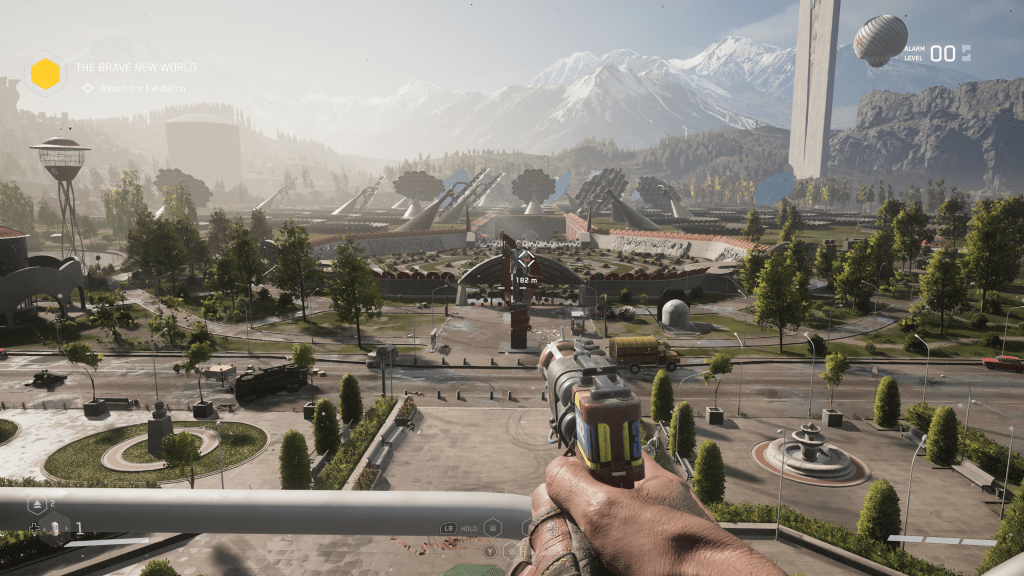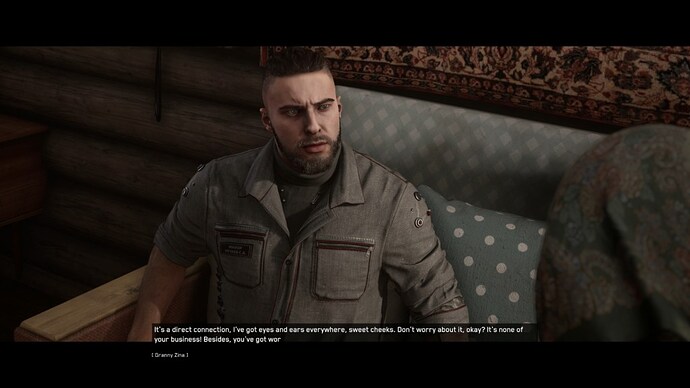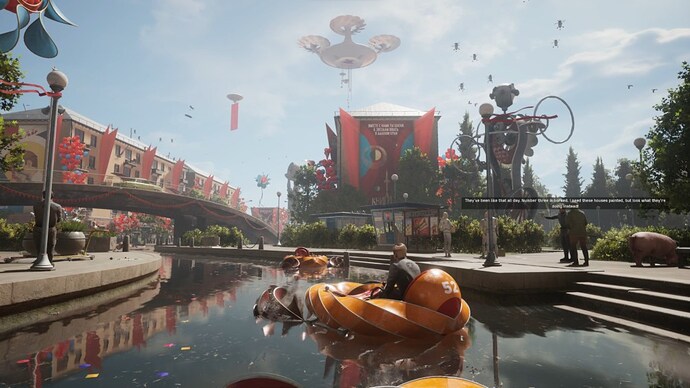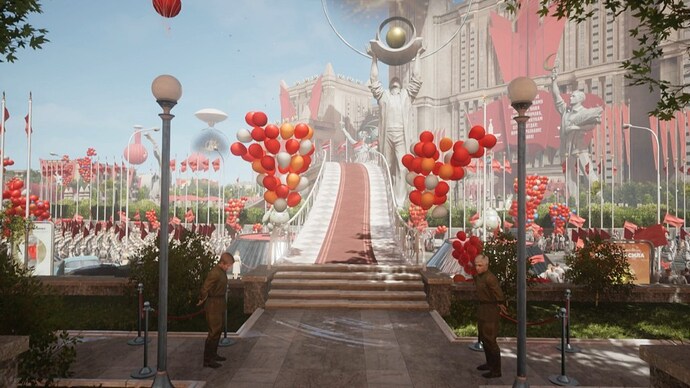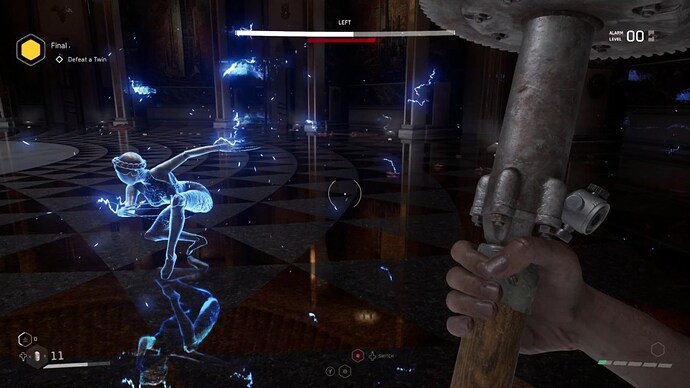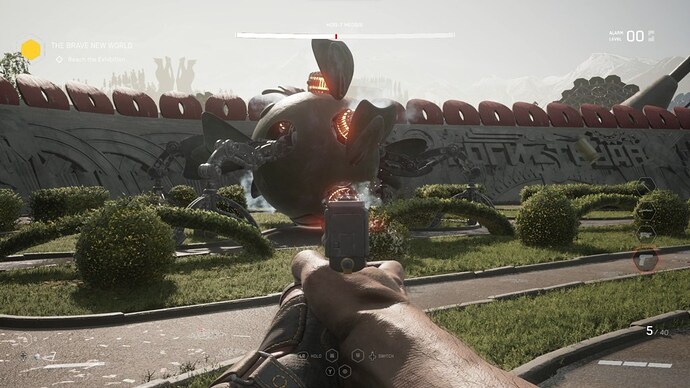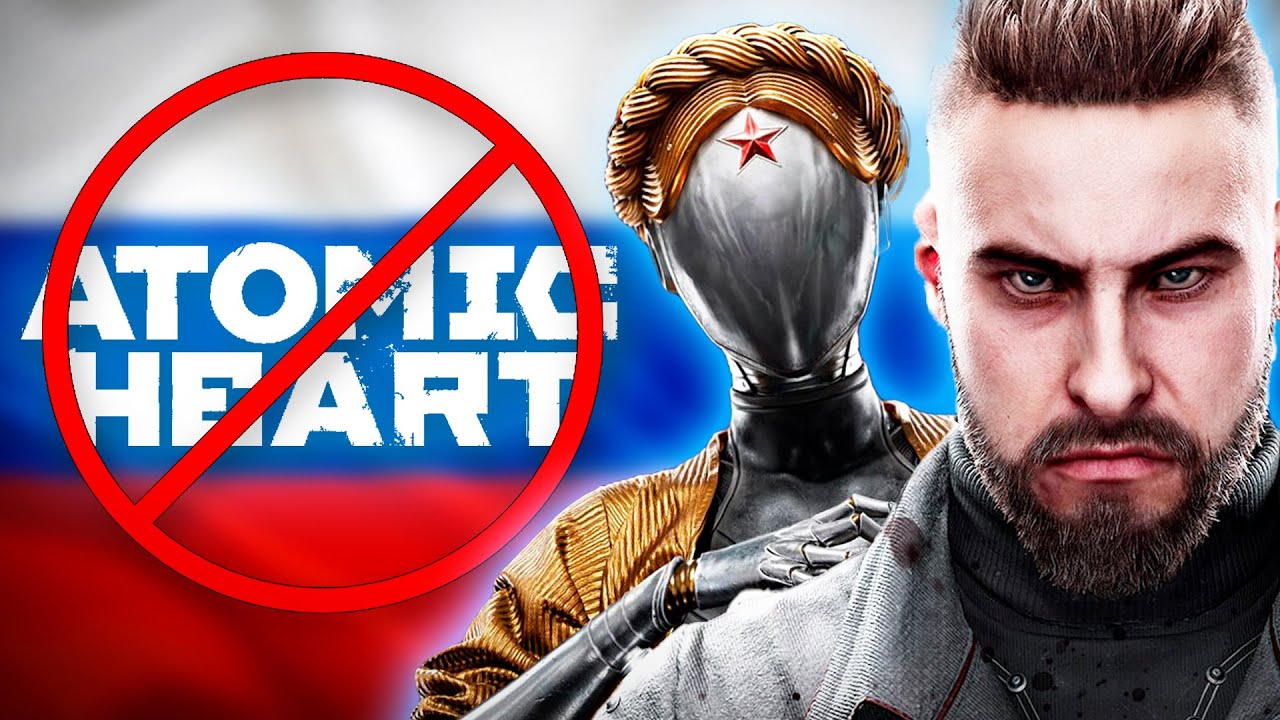Originally published at: Review | Atomic Heart - XboxEra
Atomic Heart is the first game from developer Mundfish. You are Agent P-3, and in an alternate reality 1950s Russia you work for the smartest man on the planet. His invention of Polymer has changed the course of history. Flying machines, thought control, superpowers, governmental infighting, conspiracies, and manipulation are all major themes of this excellent title. Combat can have occasional balance spikes and I ran into a lot of bugs. I loved this story that was absurd early on and by the end, one that pulled no punches in its critiques of power and those who wield it.
A Shock to the System
The “Shock” games, namely System Shock and Bioshock are clear inspirations for Atomic Heart. You’ll start the title in a city in the sky as parades are being held to honor the upcoming release of Kollectiv 2.0. Created by the Scientist Dmitry Sechenov it is a neural network that allows humans to control robots with their minds. Your player character is known as Major P-3, Dr. Sechenov’s right-hand man. Things quickly go awry and you are tasked with discovering what went wrong, why, and how to fix it.
The story starts out slowly and builds into something fantastic by the end of its 15–20-hour long runtime (if you focus entirely on the main story). There is another 10-15 hours’ worth of side content available in the form of “Polygons”, these are challenge dungeons and the main way to unlock weapon attachments and other combat-focused unlocks. As always I’ll do my best to break down the feeling of the plot without giving away any direct spoilers. P-3’s memories of anything more than two years ago were lost, as he was saved by Dr. Sechenov in a procedure that left him with total amnesia. Even if the game’s endings left me feeling slightly unsatisfied all of the major mysteries were revealed, and the journey to find them was immensely pleasing.
The entire game takes place in the vast Facility 3826, a fictional base set deep in the USSR of 1955. Atomic Heart is an odd open-world game. If they didn’t include a map when you were outdoors you might never realize it technically is one. If you focus entirely on the main quest the game never once points you in the “go explore at your leisure direction”. There is an enormous amount of playable space here, but it is mostly optional. The reward for exploring are the Polygons, aka challenge dungeons, that house three chests. Each chest yields a unique unlock for your weapons, as well as the occasional blueprint you’ll need to craft them in the first place.
There is no fast travel available, and instead, you’ll drive cars to each location. The only waypoints are those for missions so exploring the open world can become a bit frustrating. Navigating into and out of the map can take a few seconds each time, and there is no mini-map available. By the time I rolled credits, I had only completed two of the dozen Polygons and hadn’t found a few of the weapon blueprints. I could see completionists spending 30+ hours in this game easily, and warning, there are easily missed achievements tied to bosses you can only fight once. Speaking of fighting.
Swing Dash Shoot
One of my biggest concerns coming into Atomic Heart was the combat. Early gameplay showcases had a floaty, spongey feel to the hits and enemies. Three difficulty options are available, and on normal the combat is fantastic most of the time. Your first weapon is an Axe that swings nice and hard. Robot and Human limbs, heads, and torsos will melt as your axe swings clean through them and it feels damned satisfying. There are multiple melee weapons, each with its own specific upgrade paths and special abilities. My favorite was the quick-hitting axe that could turn into a ranged saw attack. To use special abilities you’ll need to use your glove’s energy. The main way to gain energy is to hit things with a melee weapon, and you’ll unlock multiple energy-based weapons that’ll use this ammunition as well. The loop of smacking enemies to build up energy so that you can use special moves and/or specific ranged weapons was fun the entire time.
There are also multiple ballistic-based weapons available, and you’ll unlock a powerful pump action shotgun early. Pistols, assault rifles, and even a rocket launcher will be yours by the end and each has its own upgrade tree. I didn’t realize just how important this was at first, and at the first major boss of the game, I experienced a massive difficulty spike. Once I realized that I had accidentally skipped the tutorial for upgrading your weapons I went into NORA, the upgrade sex robot, and powered my gear up. The boss was a cake walk and I only ran into a few more difficulty spikes throughout my time. Upgrades themselves are crafted through a large number of in-game consumables. Looting these is an immensely satisfying experience, as it is the exact opposite of Red Dead Redemption 2. Instead of slowly going through each drawer and shelf you hold out your magic glove and suck everything useful into your pocket (which sports a mini black hole of course).
Once you’ve pocketed a Walmart worth of goodies you can go to NORA to craft ammo, health packs, and consumables. A key craftable is the weapon cartridges. Ice, Fire, and Shock cartridges can add an elemental flair to your weapon of choice. Combined with moves from your glove (which we’ll hit on next) and you can take down the toughest enemies in no time. To find out what works best against each enemy type you’ll have to scan them, Metroid Prime style. It can be really hard to do so in the heat of combat though, as time does not slow down when you are scanning. The key bind is odd on console as well, where you need to double-tap and hold the right bumper. Normally right bumper is your loot and interact button, which led to me scanning a lot when I went to loot. Or trying to loot when I wanted to scan.
Y is your Shock ability, which lets you shoot out a quick bolt of electricity. Most important of all though is B, which is your dash. There is a lot of melee in Atomic Heart, and you will need to learn how to effectively dash if you want to avoid incoming damage. Polymer is the main resource you’ll need for your personal and glove ability leveling trees, and the double dash is one of the first you should go for. As far as the glove abilities are concerned my favorite was Mass Telekinesis. By the end of my playthrough, I was picking up every enemy around me in a 50-foot radius and slamming them to the ground for most if not all of their health. There are multiple glove abilities ranging from freezing sprays to polymer shields, and the incredibly useful polymer spray. The spray coats enemies and the environment in a polymer liquid that adds extra damage and effects to your elemental attacks.
There is a ton to this combat system, from how it works to the depth of its upgrades. One issue I had on multiple occasions though was the difficulty balance. There were a few bosses and multiple rooms where the game would send 10+ combatants at me which felt far more difficult than the rest. This is Mundfish’s first game and it shows through occasionally.
Fetch that Quest
The story is great, the combat is damned good most of the time, so let’s break down the mission setup. Atomic Heart might have the most “I have reached a door, now I must backtrack or visit side areas to find keys to open it” sections of any game in recent memory. The number of times I thought I was done with an area, only to find that the next door required me to turn in another direction, go fight and solve puzzles for 30 to 60 minutes and then head back was extremely high. Narratively the game does a great job of explaining why this happens, and most of the time you’re visiting new areas as you do it. Still, I found myself exasperated occasionally when “Go to Door A” invariably meant that I was going there, getting told I need to find key items, and then turning around and looking for new paths to tread before finally coming back to that same door much later.
The opening section of the game is on rails for a while, too. You get a lot of story and world-building as you meander around a parade and head to a laboratory. After a few hours of linear progression you’ll finally emerge into the open world, at which point a small slice of the map is available. Atomic Heart feels like a less restrictive Metro Exodus because the entire map is never fully available at one time and you cannot backtrack to an area once you’ve left it. This goes for the post-game as well, I found two endings and neither one allowed me back into the game world once it was completed. The bosses were mostly fantastic, with dizzying animations and easy-to-read attack patterns. The first was a massive difficulty spike that forced me to learn the upgrade system, but none took me more than 3 or 4 tries on normal.
Outside of combat, there are a lot of puzzles, with the majority of them being a few fun door lock puzzles and an extremely basic laser grid one. The door lock puzzles consist of dot matching, finger-snapping, and Skyrim-style lock picking and they were just tricky enough to be satisfying but not annoying. There are multiple other puzzle types available throughout the main campaign and they get re-used in the challenge dungeon Polygon areas. In these, the difficulty is ramped up for puzzle and combat alike, and the best I could tell if you don’t do every Polygon in an area before moving on there was no way to go back so make sure you hit them up when you can.
Atomic Heart has a lot of dialogue in the game and you can make multiple choices in most conversations. They didn’t seem to change anything, and lines could be repeated as often as you wanted with most of the NPCs. I found myself reminded often that this is their first game as dialogue would play over top of itself, repeat unprompted, or subtitle boxes would linger until I had done a full game quit, and reopen. I ran into a lot of bugs and performance issues overall, including a few that almost sunk my playthrough.
Unreal Engine 4 Holds Up Real Well
Graphically Atomic Heart looks great on the Series X. I started my playthrough on PC. My AMD rig and its 5800x and RX 6700 XT ran the game at max settings and 1440p while averaging around 100 FPS. The Series X aims for a dynamic 4k/60FPS and holds it consistently in gameplay. The biggest hit graphically that I noticed were the shadows, which were clearly defined on PC. The console version had them, but they were closer to low settings than they were to Ultra. Cutscenes were a mixed bag, with an aim for 60fps that was rarely hit. Some of them even dropped to what felt like the teens occasionally. There was a clear shift in the quality settings when the game attempted a shift from cutscene directly into gameplay. The framerate would jump back to 60 and the detail on textures and shadows would noticeably dip.
There are some dreamlike sequences where the world shifts around you as well, and when that happened the texture pop-in and stutter hit hard for a second every time. I don’t believe that this game is using most of the new Unreal Engine 5 features. Still, it looks fantastic, and the art style of this alternate USSR can be downright stunning. The scale outdoors is immense, with zero loading screens outside of starting up the game fresh or coming back after a death. The title is coming to the previous generation of consoles, but I don’t have any of those laying around. I cannot imagine it will run particularly well on any of them in the outdoor sections. Indoor may work well, and a lot of the game does take place inside. There is a lot of gore here, in hilariously awful ways. You’ll come across hundreds of corpses and more often than not you can chop them into a pile of arms, legs, torsos and heads. The detail on the gore is quite high, and robot enemies get sliced to bits in a similar fashion. I love it.
The biggest issue I had were the numerous graphical bugs I ran into. Enemies would spawn into walls or ceilings and their AI would break as they couldn’t figure out how to get to me. This normally was a plus as I could just smack them in the back for a while until they died. Twice though this happened with a mini-boss that I had to kill before I could proceed. He was stuck up in the ceiling and was immune to damage, so that meant closing the game and opening it back up while hoping that they spawned incorrectly. A room in one of the mid-game missions refused to spawn its floors and wall textures. This meant every time I walked into it that I fell, forever. I let it go for 20 minutes just to see if it would ever end, it didn’t. After three full system restarts failed to load the room properly I uninstalled and redownloaded all 77gbs of the game, and thankfully that worked. Not ideal!
Voice Acting, Writing, and Music
Atomic Hearts defaults to English, but you should not use that if you can use subtitles properly. The English V.O. is pretty terrible, and there are EIGHT other voiceovers available. I used the Russian audio track with English subtitles and it was excellent. Occasionally, well often, my character would talk during combat and no subtitles played. Some of the in-game computer text that gave backstory and lore was in Russian as well, but it only happened twice near the end. Other than those issues the Russian VO and written English translation were superb. Atomic Heart is smart, and more impressively it’s funny as hell.
Few video games are genuinely funny, and even fewer never delve into cringe. Atomic Heart never once missed on a joke or plot point. Your character isn’t an idiot to advance the plot, and no character is. There are a ton of secrets and varied motivations, and it always felt earned when I found out why someone had kept something from me. Characters have depth and none fits an easy-to-define mold. From the crazy Granny with her flying house to even the main protagonist they’re all realistic with their motivations, abilities, and faults.
Another major highlight is the soundtrack. All the great songs from the trailers over the years are here. The reason why current pop music makes sense here is the “radio of the future”, a plot device that uses quantum computing and polymer to “guess” what music up to 80 years in the future will sound like. There is a lot of licensed Russian pop, rap, and rock music that fits the tone of the game and its absurdist takes well. The piano ditty that plays in the upgrade screen was a standout for me as well.
In Conclusion
Atomic Heart is an excellent game, and it’s an incredible debut title from Mundfish. Clever storytelling, massive set pieces, fun combat, and more make this one easy to recommend. Hell, it’s on Game Pass Day One, so go pre-install it already and enjoy this ridiculous ride.
![Review | Atomic Heart [4K]](https://forum.xboxera.com/uploads/default/original/3X/a/5/a5aef9bb8f5e5bac6fdf33ee9d95ce22eed52a0b.jpeg)
